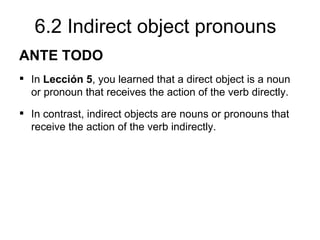
6.2 Indirect object pronouns
- 1. 6.2 Indirect object pronouns ANTE TODO In Lección 5, you learned that a direct object is a noun or pronoun that receives the action of the verb directly. In contrast, indirect objects are nouns or pronouns that receive the action of the verb indirectly.
- 2. 6.2 Indirect object pronouns Note the following example: SUBJECT I.O. PRONOUN VERB DIRECT OBJECT INDIRECT OBJECT Roberto le presta cien pesos a Luisa. Roberto lends 100 pesos to Luisa. An indirect object is a noun or pronoun that answers the question to whom or for whom an action is done. In the preceding example, the indirect object answers this question: ¿A quién le presta Roberto cien pesos? To whom does Roberto lend 100 pesos?
- 3. 6.2 Indirect object pronouns SINGULAR PLURAL me (to, for) me nos (to, for) us te (to, for) you (fam.) os (to, for) you (fam.) le (to, for) you (form.) les (to, for) you (form.) (to, for) him; her (to, for) them
- 4. 6.2 Indirect object pronouns ¡ATENCIÓN! The forms of indirect object pronouns for the first and second persons (me, te, nos, os) are the same as the direct object pronouns. Indirect object pronouns agree in number with the corresponding nouns, but not in gender.
- 5. 6.2 Indirect object pronouns Using indirect object pronouns Spanish speakers commonly use both an indirect object pronoun and the noun to which it refers in the same sentence. This is done to emphasize and clarify to whom the pronoun refers. I.O. PRONOUN INDIRECT OBJECT Ella le vende la ropa a Elena. Les prestamos el dinero a Inés y Álex.
- 6. 6.2 Indirect object pronouns Using indirect object pronouns Indirect object pronouns are also used without the indirect object noun when the person for whom the action is being done is known. Ana le presta la falda a Elena. Ana lends her skirt to Elena. También le presta unos bluejeans. She also lends her a pair of blue jeans.
- 7. 6.2 Indirect object pronouns Indirect object pronouns are usually placed before the conjugated form of the verb. In negative sentences the pronoun is placed between no and the conjugated verb. Martín me compra un regalo. Martín buys me a gift. Eva no me escribe cartas. Eva doesn’t write me letters.
- 8. 6.2 Indirect object pronouns When a conjugated verb is followed by an infinitive or the present progressive, the indirect object pronoun may be placed before the conjugated verb or attached to the infinitive or present participle. Él no quiere pagarte. He does not want to pay you. Él no te quiere pagar. He does not want to pay you. Él está escribiéndole una postal a ella. He is writing a postcard to her. Él le está escribiendo una postal a ella. He is writing a postcard to her.
- 9. 6.2 Indirect object pronouns ¡ATENCIÓN! When an indirect object pronoun is attached to a present participle, an accent mark is added to maintain the proper stress. For more information on accents, see Pronunciación, and Ortografía.
- 10. 6.2 Indirect object pronouns Because the indirect object pronouns le and les have multiple meanings, Spanish speakers often clarify to whom the pronouns refer with the preposition a + [pronoun] or a + [noun]. UNCLARIFIED STATEMENTS Yo le compro un abrigo. Ella le describe un libro. Él les vende unos sombreros. Ellos les hablan muy claro. CLARIFIED STATEMENTS Yo le compro un abrigo a él/ella/usted. Ella le describe un libro a Juan. Él les vende unos sombreros a ellos/ellas/ustedes. Ellos les hablan muy claro a los clientes.
- 11. 6.2 Indirect object pronouns dar SINGULAR PLURAL yo doy nosotros/as damos tú das vosotros/as dais Ud. / él / ella da Uds. / ellos / ellas dan Mi abuela me da muchos regalos. Te digo la verdad. My grandmother gives me lots of gifts. I’m telling you the truth. No les digo mentiras a mis padres. Voy a darle consejos. I don’t tell lies to my parents. I’m going to give her advice.
- 12. 6.2 Indirect object pronouns ¡ATENCIÓN! Here are some common expressions with dar: dar consejos to give advice dar un regalo to give a present dar una fiesta to throw a party
- 13. 6.2 Indirect object pronouns ¡INTÉNTALO! Use the cues in parentheses to provide the indirect object pronoun for the sentence. 1. Juan quiere dar _____ un regalo. (to Elena) 2. María _____ prepara un café. (for us) 3. Beatriz y Felipe _____ escriben desde Cuba. (to me) 4. Marta y yo _____ compramos unos guantes. (for them) 5. Los vendedores _____ venden ropa. (to you, fam. sing.) 6. La dependienta _____ enseña los guantes. (to us)
- 14. 6.2 Indirect object pronouns Answer Key 1. Juan quiere darle un regalo. 2. María nos prepara un café. 3. Beatriz y Felipe me escriben desde Cuba. 4. Marta y yo les compramos unos guantes. 5. Los vendedores te venden ropa. 6. La dependienta nos enseña los guantes.